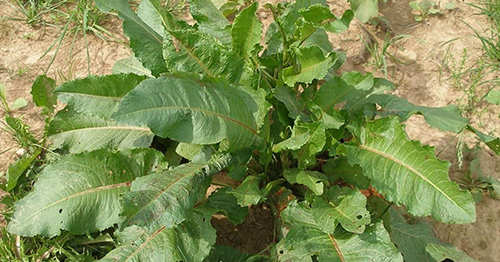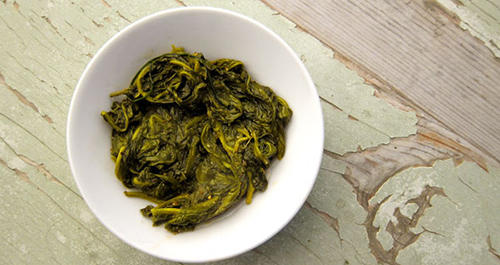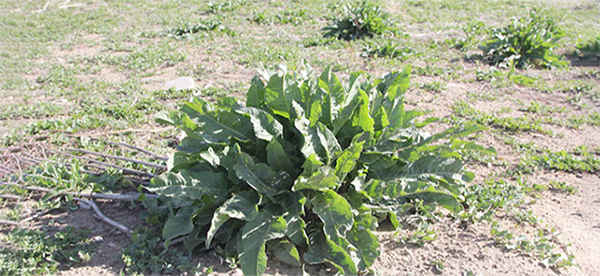We often get caught up in getting rid of the weeds in our yards so that it’s perfect. It’s an ongoing battle for a lot of people to make sure that any and all “weeds” are eradicated from their property. However, there’s one “weed” that you might want to think twice about pulling, cutting, or spraying with herbicides the next time you take to the yard for weeding.
It’s often called dock weed, but it’s also known as yellow dock, curly dock, or curled dock. The scientific name for this plant is Rumex crispus. It’s a perennial, meaning that it grows back year after year, and it’s commonly found across North America, in the United States and southern Canada.
What Does Dock Weed Look Like?
This weed grows about three feet tall. It has a flower stalk that has small yellow-green flowers and, later, brown seeds covering it. One of the defining characteristics of this plant is the way the seeds can stick to animals, so that they can be carried away to be germinated elsewhere. The leaves are oblong and smooth, and extend from the stem in a swirl pattern. It’s a pretty hardy plant, even to the point that it’s considered an invasive species in many places it grows, so you can expect to find it growing in any number of environments.
The leaves can be harvested from mid spring to early summer, and the seeds can be collected through the summer and fall months. Leaves for consumption should be harvested while tender and young, since they get too bitter for consumption when they’re mature.
Uses for Dock Weed
Despite its proclaimed status as a weed this plant can be very useful. Since it’s found almost everywhere, and can survive in harsh conditions, learning how to utilize this versatile plant could come in very handy in a survival situation.
Here are some of the ways you can use this rough-and-tumble plant.
Related: 10 Edible Roots That Kept This Hermit Monk Alive
Dock Weed is Edible
The young leaves of the dock plant can be consumed and have a tart, lemony flavor. The raw leaves should be eaten sparingly, but can be eaten in a salad in small amounts. The leaves can also be boiled several times in clean water to leach them of the high levels of oxalic acid that they contain, so that they can be eaten in larger amounts.
When consumed, dock weed is a good source of several vitamins and minerals that we need to stay healthy including vitamin C and vitamin A, plus magnesium, manganese, and iron. Because of significant amounts of nutrients, it’s often used to treat nutrient deficiencies like scurvy, caused by lack of vitamin C, and anemia, which can be due to a lack of iron in the diet.
Dock is Often Used for Skin Issues
This plant is thought to be effective in treating several different skin issues. One general use for this plant is in treating rashes.
Its antibacterial properties make it great for treating mild bacterial infections of the skin, like acne. It also has anti-fungal properties that make it perfect for treating conditions that are caused by fungal infections, such as athlete’s foot.
It’s also frequently used for treating chronic skin conditions like eczema and psoriasis. Aside from actually treating these conditions, it is often used to help alleviate the symptoms that accompany them like itching and burning of the skin. People also sometimes use this plant to reduce the look of age spots.
It can be made into a paste or poultice, taken internally, or brewed into an infusion for use in treating skin problems depending on the issue.
It May Help Respiratory Issues
In homeopathy, this weed is used to treat a ticking cough. It’s also frequently used to treat inflammation of the airways and nasal passages. It may help with conditions like bronchitis or the common cold due to these effects.
To use for cough, you can brew the root of the plant into a tea and drink three or four cups a day until symptoms disappear.
It is Used as an Inflammation Fighter
Dock is often used to fight inflammation. Because of its inflammation fighting properties, it’s often used a treatment for arthritis and other conditions caused by chronic inflammation. These include fibromyalgia, rheumatism and gout. It’s thought to help decrease inflammation by cleansing the blood and reducing toxicity.
It is thought to help maintain the health of the lymph nodes, encourage drainage of them and reduce swelling. It may also have some effect at reducing fevers.
The root is the part of the dock plant you want for fighting inflammation. Dry the roots and put them in capsules, or brew them into tea with a combination of other inflammation-fighting components like mint leaves and fennel.
It Can Be Used as a Laxative
Dock weed has laxative effects that can be harnessed to fight constipation. The issue with using this particular plant for this purpose is that people experience various levels of effectiveness, so this isn’t a cure you necessarily want to count on.
To use curly dock as a laxative you can simply consume the leaves, dry the leaves and roots and put them in capsules, or you can boil them into a tincture and take several drops of it a day.
Dock Weed Warnings
Be careful about introducing this weed to new areas as it may become an invasive species, damaging the natural ecosystem in an area.
When eating dock weed, make sure that you indulge in moderation. Too much of this green can lead to urinary tract issues and could potentially cause kidney stones. It may also have a laxative effect and cause stomach pain or cramps in some people.
This plant has several uses that could come in handy in a SHTF situation but be sure you follow the normal protocols for wild edibles. Make sure you’re absolutely certain that you’ve identified the plant correctly or you could wind up taking in a toxic plant that could do far more harm than dock weed could ever do good.
You may also like:
 All-Natural, Home Remedies for High Blood Pressure
All-Natural, Home Remedies for High Blood Pressure
This Bug Will Kill Most Americans During The Next Crisis (Video)
23 Medicinal Plants the Native Americans Used on a Daily Basis















Same grows in Europe (England at the very least) there it’s best know for its anti sting application, we get tonnes of stinging nettles, docks always grow near by, so if you get stung, find a dock leaf, fold it a couple of times and tear it, then rub the torn bit (and the juice) on the stung area, and the sting reduces, then grab another leaf, repeat till all fine (you might be a bit sticky though)
Yep, I was taught that by a great aunt when I was about 5. If there are stinging nettles there’s Doc somewhere around. It works!
Keep this in mind anywhere of poisonous plant grows its cure usually is within 10 to 15 ft.. in another plant source
Dock can also be used for bee stings to relieve the itch.Wad up a leaf and crush it well in the palm of your hand till it feels a bit wet.Rub it on the bee sting. In a few minutes the itch is gone! So is the swelling.
‘Nother good article! From 1900 to1950 the part of Texas I’m in was one of the great cotton growing regions of the world. Sharecropping wasn’t as widespread as in places like the Yazoo Delta in Mississippi but as late as 1980 there were still quite a few old sharecropper shacks in the area occupied by Grandma and Grandpa who had worked in the fields. Used to see the old women in the early spring out along a levee in the bottoms of the East Fork of the Trinity gathering early greens, docks, dandelions, and mustard the main ones. One spring during some high water I stopped along the road because one of the old women was out in a field flooded knee deep and I was worried about her. Haha on me cause she bent down and snatched up a carp that had to weigh better than 20 pounds and came wading out of that field clasping that big fish to her breast like it was a lost child.
When you are poor or, perhaps, surviving TEOTWAWKI winter is a great nutritional challenge and if you survive it you need to know about the healing nutrition of docks and the early greens, and lots of simple little fun facts like the habit big carp have of wandering into the fields during a flood.
How could there be any nutrients left if you boiled it several times to get the oxalic acid out? Sounds like time should be spent on other things.
Boiling may reduce levels of some nutrients, but surely we all understand that it doesn’t remove all of them. It’s high in oxalic acid, and the last thing you want in SHTF is a kidney stone. It’s an option. Options are good to have, and the knowledge of them will help a lot if you’re in a situation where you must use dock weed.
I hate initials. I do not know what SHTF is, please explain.
SHTF = shi* hits the fan